Specimens and proofs
PROOF certificates
What are proofs?
Proofs certificates are NOT like proof coins. Proof coins are specially-produced mint products made for collectors. Proof certificates were special impressions made for printers and artists during the production of printing plates. In effect, they were draft copies of parts or sides of certificates being designed and engraved. They were private productions, never intended for the public.
Imagine an engraver working on a vignette that might take fifty or more hours to complete. The image might look acceptable when carved in steel or copper. However, the artist would never know if the vignette were perfect until printed on paper.
Similarly, imagine how hard it would be for letter engravers to notice minor spelling mistakes when carving or etching forty or fifty lines of text. Obviously, the easiest way to find mistakes is to print the engraving on paper. Proof impressions may represent fully completed designs or they may represent partial impressions meant to check features before completion.
Engravers often "pulled" proofs at several times during the engraving/etching process. "Progress proofs" often represented successive impressions while artists and engravers made design improvements as they worked toward final designs. Proofs may also have represented quick tests to see if shading was too light or too dark or if designs would print well. Imagine the frustration if an engraver had worked for a week on a portrait only to find that lines needed to be carved differently because the plate would not take or transfer ink properly.
"Color proofs" are fairly common. They were meant to test the appearances of borders when printed in color. Lathework border designs and underprints were usually meant to be unique between varieties , but the intricate designs did not always reproduce well in all colors. "Trial color proofs" were often experimental efforts to find colors that either printed well or were most attractive to clients.
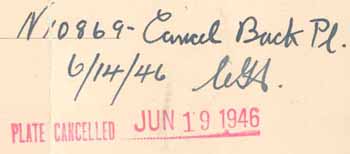
"Cancellation proofs" usually represent file copies of final plate designs. When plates were no longer needed, notes were often recorded on the proofs testifying to final uses and dates when printing plates were destroyed.
Engraving/Printing Companies
A few proofs are known from most of the major printing companies, although American Bank Note Company accounts for at least 75% of those whose names have been reported.
Paper
Proofs were often printed on the type of paper handy at the time. Paper might range from thin India paper to thick, soft card stock. Proofs appear on so many different kinds of paper that it seems apparent that paper quality was usually unimportant.
Numbering
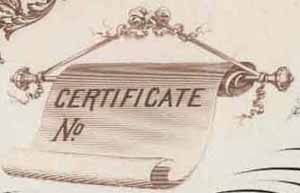
Proofs were NOT serial numbered, but almost always show blank areas or ornaments meant to hold serial numbers.
Condition
Proofs were never meant to circulate. They were intended for prosaic purposes such as error checking and record keeping. Most proofs are marked with pen, pencil, and crayon. Many were folded and torn. Missing pieces are common. Coffee stains, even coffee cup rings, are seen. Preservation seems to have been an afterthought at best.
Marks
As shown by the bond below right, a large percentage of proofs are marked in some manner. Plate numbers in pencil are very common. Dated company approvals frequently appear on proofs of finished plates. Red or black crayon marks are extremely common. Unless otherwise indicated, collectors should assume that all proofs are marked in one or more places. Proofs were interim items. Therefore there was rarely, if ever, a need for formal cancellation in the form of punches and pen markings.
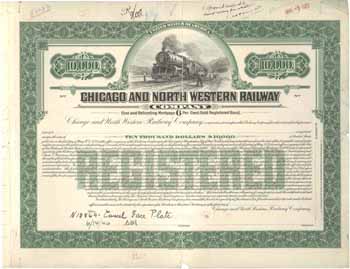
Peripheral material
Proofs were often stored in engraving company files with letters, notes, and all sorts of peripheral material. Auction companies generally include whatever related documents may have been found with the related proofs.
Features of proofs
Although highly variable in appearance and purpose, proofs share certain commonalities.
- Proofs are unique or nearly so; rarely do two identical proofs exist.
- Partially-printed designs are common.
- Proofs are never serial numbered.
- Proofs are commonly printed on one side only.
- Proofs are rarely cancelled.
- Proofs are often notated with handwriting and other marks.
- Proofs are often found in distressed conditions
- Proofs are rarely signed by engravers.
- Proofs often show ink smears.
- Proofs printed on very thin paper are often found attached to thicker card stock.
- Proofs printed on thicker card stock often show foxing.
- Proofs do not show impressed or applied corporate seals.
Valuing proofs
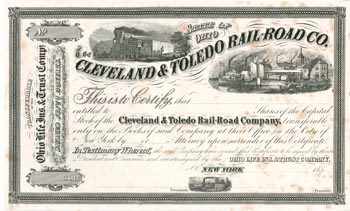
With rare exception, proofs are unique collectibles. This makes proofs the quintessential example of how collector demand is so much more important than rarity.
In companies crowded with many different varieties of certificates, proofs often experience very little demand. Even though they are unique, some proofs may sell for under $30. Proofs from high-demand states where there are many collectors bidding for few certificates, proofs of any kind fetch high prices, even those in horrible conditions.
Origin of proofs
Most, if not all, proofs are in the collectors' market only because they were liberated from engraving company archives. Several large sales over the past quarter century have placed items from American Bank Note Company archives all over the globe. Proofs from small engraving companies are very rare.
Fronts versus backs
When auction companies sold American Bank Note Company proofs, they often sold all available proofs of varieties together. Throughout this catalog, whenever you see proofs of the faces of certificates listed, you may assume one or more additional might exist, but I am lacking descriptions. Orphaned fronts, backs, and coupons, even single coupons exist, but my information about those items is meager.
SPECIMEN certificates
What are specimens?
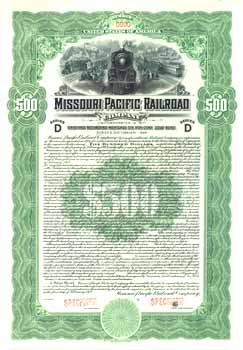
In the physical sciences, "specimens" are like examples of rocks, plants, insects, and animals retained for future study and classification. Similarly, in our hobby, specimens are examples of fully finished, regular certificates retained for some future purpose.
Specimens were often preserved to help detect counterfeits. Many, however, were probably retained simply as file copies, as souvenirs, or as promotional examples for future engraving business.
Numbering
American Bank Note Company and most of the other major engraving companies normally numbered their specimens 00000, 0000, or 000 in red or blue ink. That is not a hard and fast rule because some are unnumbered. We don't know exact numbers, but it appears that engraving companies normally supplied several specimen copies to their clients along with regularly numbered certificates. It appears that large engraving companies retained a few specimens for their own records.

Many Canadian certificates were printed in England by Bradbury Wilkinson which normally numbered its specimens with letters and number in units of 1000 (e.g. B1000, V5000 etc.)
Security-Columbian Bank Note Company was notorious for not numbering its specimens. Its specimens were normally blank and often indistinguishable from normal unissued certificates except for pairs of small punched holes in the signature areas.
Like every other "rule" in this hobby, specimens are also known with serial numbers. It appears that small printing companies usually did not provide specimens to their customers. In those cases, railroad companies often saved a few regularly-numbered certificates as specimens. Sometimes, they even saved issued and cancelled examples as specimens. In most cases, but certainly not all, companies stamped or hand-wrote the word "specimen" on certificates. These kinds of specimens often confuse new collectors because they don't look "official." Those kinds of specimens are very scarce or unique.
Engraving/Printing Companies
Many sellers do not report printer names, so we cannot know exact percentages. However, American Bank Note Company is known to have printed at least two-thirds (over 5,500) of the known varieties of specimens. The next closest companies reported were International Bank Note Company (slightly over 200 reported specimens) and Homer Lee Bank Note Company (slightly over 175 as of early 2024.)
Cancellation

The majority of specimens were neatly punch-cancelled with two 1/8" holes in the areas meant for corporate signatures. Most were also stamped or overprinted with the word "specimen" in red,, blue, or black ink.
Bradbury-Wilkinson specimens were often pinhole cancelled with the word "Specimen" and a date. Beware that pinhole cancellations are often hard to identify in small or poor quality photos. Pinhole-cancelled American specimens (like this example from Hamilton Bank Note Co.) are uncommon.
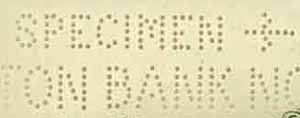
Features of specimens
Like everything else in this hobby, specimens do not conform to any 100%-reliable rule. That can make some specimens hard to distinguish from ordinary, unissued certificates. Normally, though, specimens share most of these features.
- Cancellation with two 1/8" holes in typical signatures areas.
- Printed or rubber-stamp impression of the word "specimen".
- Serial number 000, 0000, 00000, or close variations. Sheets of coupons usually show the same numbering.
- Pristine condition, although most are folded.
- Unsigned.
- Printed front and back, identical to regular certificates.
- No embossed or applied corporate seals.
- No indication of issuance or transference.
- Rubber-stamp impression, often on the front, with text similar to: "Last specimen; return to file room."
Number extant
It is usually impossible to determine how many specimens may exist. Some specimens are unique, while as many as 10 or more examples may exist for others. For the most part, specimens are scarce to rare.
Valuing specimens
Specimens are priced by how much collectors want them. Simply put, prices are related to demand. It is very common for specimens from high-demand states to exceed $500, even $1500! At the same time, even in the same auction, equally rare specimens from more common Eastern railroads may sell for less than $50.
Collectability
Many collectors buy only issued certificates and thereby avoid specimens. Beginners often avoid specimens because they do not know their intents and histories If specimens represent the only known examples of specific varieties, then collectors tend to pay high prices. Conversely, if certificates of the same variety are known in other conditions, then pricing tends to be lower. If issued and unissued examples of the same variety are known, then specimens tend to be priced like issued certificates.